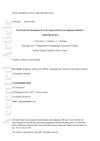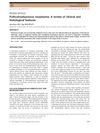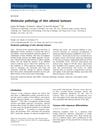TLDR Trichofolliculoma has specific cytokeratin patterns that help in its diagnosis.
The document presented a case report on trichofolliculoma, a rare benign hair follicle tumor, and included an immunohistochemical study focusing on cytokeratins. The study was conducted by a team from various departments in Japan, including dermatology, plastic and reconstructive surgery, and pathology. The findings highlighted the specific expression patterns of cytokeratins in trichofolliculoma, contributing to a better understanding of its histopathological characteristics. This research provided valuable insights into the diagnosis and differentiation of trichofolliculoma from other skin lesions.
133 citations
,
March 1999 in “Journal of Cutaneous Pathology” Trichoepitheliomas and some basal cell carcinomas likely come from hair follicle stem cells.
128 citations
,
February 1992 in “British Journal of Dermatology” Basal cell carcinomas likely originate from hair follicle cells or stem cells.
 17 citations
,
June 2017 in “British Journal of Dermatology”
17 citations
,
June 2017 in “British Journal of Dermatology” The article concludes that hair loss is a common side effect of drugs treating skin cancer by blocking the hedgehog pathway, but treatment should continue, and more selective drugs might prevent this side effect.
 7 citations
,
March 2017 in “Journal of dermatology”
7 citations
,
March 2017 in “Journal of dermatology” The conclusion is that accurately identifying folliculosebaceous tumors requires understanding their clinical signs and microscopic features.
12 citations
,
November 2018 in “Archives of Dermatological Research” 7 citations
,
June 2017 in “Journal of Cutaneous Pathology” Cystic panfolliculoma resembles hair follicle tumors due to specific cell interactions.
 16 citations
,
July 2021 in “Histopathology”
16 citations
,
July 2021 in “Histopathology” New markers and pathways have been found in skin tumors, helping better understand and diagnose them.


